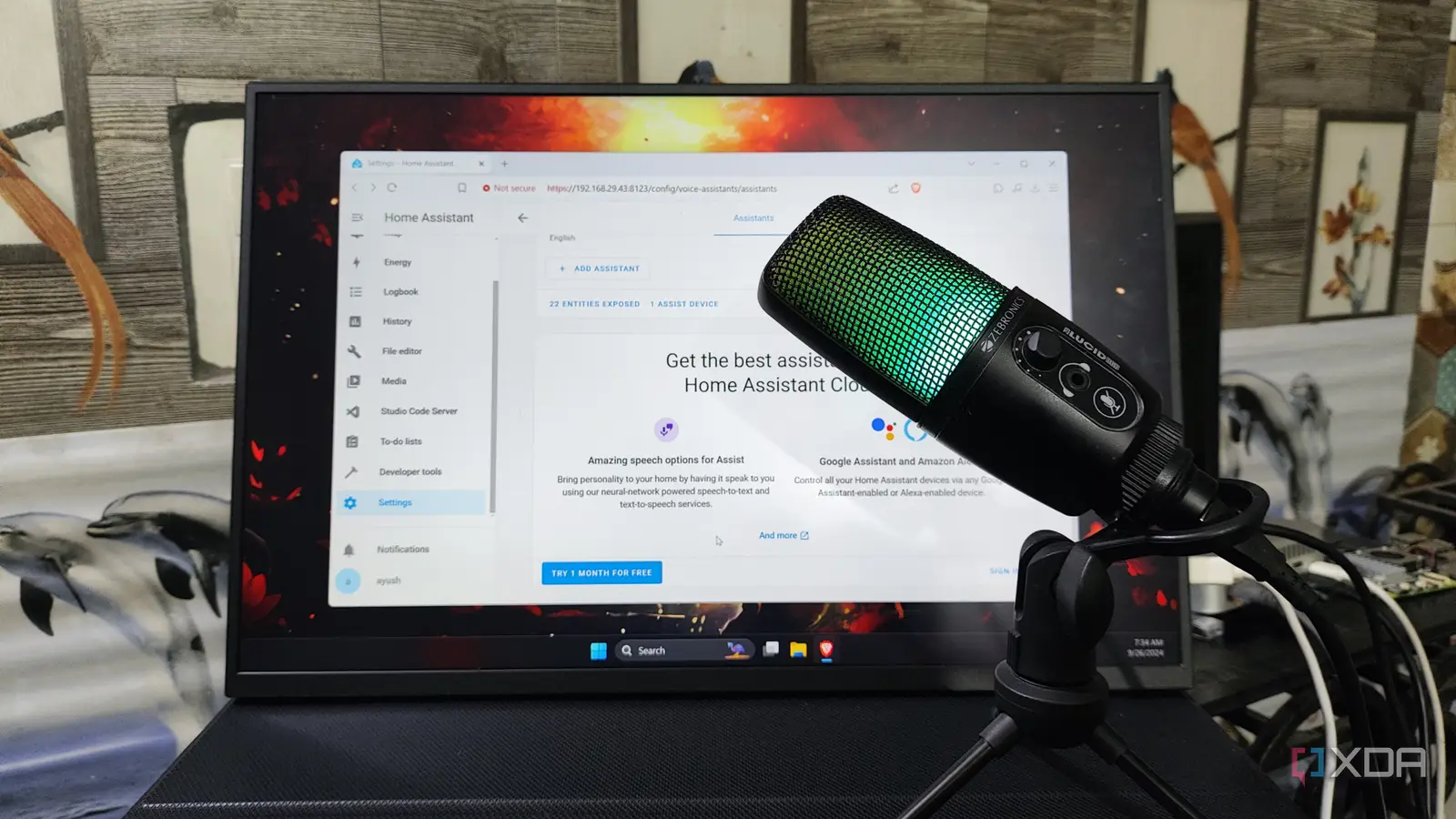This open-source project turns old PCs into voice controllers for Home Assistant – and it’s completely free

Voice control has become the default interface for many smart homes, but it usually comes at a cost. Amazon, Google, and Apple all push their own ecosystems where your voice data lives in the cloud, limiting your choices while expanding theirs. Wyoming Satellite takes a different approach. It is a free, open-source project that lets you turn nearly any PC into a local voice controller for Home Assistant. That alone makes it appealing, but there are deeper reasons why this project matters and why it deserves serious consideration.
The core argument for Wyoming Satellite is simple: it gives you whole-home voice control without giving up ownership of your hardware or your data. You can recycle an old mini PC, a laptop, or even a Raspberry Pi to serve as a “satellite” in each room, and they do not need to be powerful machines to do the job. Instead of relying on a proprietary device that phones home, you end up with a network of self-hosted voice endpoints that speak directly to your Home Assistant instance. The result is privacy-friendly, endlessly flexible, and surprisingly effective for a project that remains lightweight. It demonstrates that you can get most of the same benefits of consumer smart speakers without accepting their limitations.
Why a self-hosted voice controller is worth it
A balance of flexibility, privacy, and control
Running the Wyoming Satellite means you can place a microphone and speaker anywhere in the house without adding another closed ecosystem gadget. The system integrates with Home Assistant through the Wyoming protocol, which handles audio streaming, discovery, and coordination. Because of that, adding a new room is as easy as spinning up another satellite, whether it is on a thin client, a spare laptop, or a small single-board computer. The whole setup feels modular in a way consumer devices rarely do, and that modularity is part of the appeal. You get a system that grows at your pace rather than one tied to the release schedule of a major vendor.
Privacy is another key draw for anyone who values control over their home environment. With Wyoming Satellite, your voice recordings do not have to leave your network unless you deliberately configure them to. While big tech smart speakers offer unmatched convenience, they also tie you to data collection practices you may not want or may not fully understand. Every command and every response with this system stays local, reinforcing the principle that your home should belong to you. That reassurance appeals to hobbyists who enjoy tinkering, but it also matters for anyone who wants confidence that their house is not doubling as a microphone for a corporation.
The GitHub repository for Wyoming Satellite focuses on hosting the software with a Raspberry Pi. However, any computer that has a microphone and Python 3.7 or newer will work. My recommendation, if you’d rather not use a Raspberry Pi, would be a mini PC with Debian installed.
Cost is also worth noting, because it reframes the equation for whole-home voice control. Dedicated smart speakers are cheap upfront, but they lock you into specific ecosystems and eventually wear out or lose support. Wyoming Satellite uses hardware you probably already own, or can source secondhand for very little money. Old thin clients and mini PCs that would otherwise gather dust can be repurposed into powerful voice endpoints that last as long as the hardware does. That lowers the barrier to having voice control in every room without multiplying expenses, which makes it a brilliant choice for people who want more reach without a growing pile of proprietary boxes.
Where Wyoming Satellite falls short
Trade-offs compared to polished smart speakers
For all its benefits, this approach is not perfect, and anyone considering it should go in with realistic expectations. Setup requires some technical patience, especially with audio devices that may not behave consistently across different operating systems. Consumer smart speakers are designed to be plug-and-play, while Wyoming Satellite might need careful tuning of microphones, gain levels, and wake word models to achieve reliable performance. If you are not comfortable editing configuration files or trying different flags, you may find the initial learning curve frustrating. It is powerful, but it is not polished in the way commercial gear has to be.
The voice experience itself also has some limitations compared to polished commercial systems. Wake word detection is less consistent than Alexa or Google Assistant, which have years of refinement and massive data models behind them. Noise handling can be improved with suppression filters, but it still does not match the advanced beamforming arrays inside modern smart speakers. You will get reliable function, but not always the seamless responsiveness of big-brand devices that optimize for every edge case. For some households, that difference may be a deal-breaker, while for others it may be an acceptable trade-off.
There is also the matter of upkeep, which is often overlooked in open-source projects but becomes very real once you run them in the long term. Because it is community-driven, Wyoming Satellite evolves quickly; however, this also means that updates may occasionally break existing functionality or introduce unexpected behavior. You are responsible for maintaining each satellite and making sure it stays in sync with your Home Assistant instance, which can add to the list of weekend projects. For some, that tinkering is the fun part and the reason they chose Home Assistant in the first place. For others, it could feel like ongoing overhead compared to an appliance that “just works.”
Why it is still the more intelligent choice
Control and customization outweigh the rough edges
Despite these shortcomings, Wyoming Satellite fills a gap that commercial devices never could. It provides a self-hosted, scalable alternative where you decide how your voice system works and where it lives. The flexibility of placing satellites wherever you want and customizing their behavior for different rooms allows you to design an experience that fits your home, rather than one dictated by a company. You can even decide whether each room should detect the wake word locally or rely on the central Home Assistant instance, which adds another layer of customization. That level of control is rare in consumer smart speakers and shows why this project resonates with people who want something more adaptable.
The core argument for Wyoming Satellite is simple: it gives you whole-home voice control without giving up ownership of your hardware or your data.
That sense of ownership matters for more than just privacy, because it creates room for experimentation. You can tie Wyoming Satellite into custom automations, use your own wake words, or experiment with different text-to-speech voices. If you want a system that can grow alongside your smart home, this modular approach has far more potential than a locked-down smart speaker. It is not always as smooth, but the payoff is control and adaptability, which may matter more to someone who prefers to own their setup from end to end. That ownership mindset is one of the defining traits of Home Assistant users, and Wyoming Satellite extends it naturally.
For enthusiasts who already run Home Assistant, Wyoming Satellite feels like a logical next step rather than a bolt-on. It respects the same philosophy: keep things local, remain flexible, and let the user decide what works best. It also mirrors Home Assistant’s trajectory of turning what was once an experimental project into something robust enough to rival commercial options. If you value those principles, then living with a few quirks is a small price to pay for what you gain. That trade-off is the essence of why this project is worth exploring.
Considering the alternatives
Smart speakers offer simplicity, but not freedom
The obvious counterpoint is that consumer smart speakers exist precisely to avoid all this hassle. They are inexpensive, well-engineered, and polished to the point where anyone can set one up in minutes without reading a manual. If your goal is pure convenience, it is hard to beat plugging in an Echo or Nest and calling it done. For many people, the balance of ease and reliability is enough to make them the best choice, and there is no shame in prioritizing convenience. That is why they remain so dominant in the market despite alternatives.
But simplicity has its cost, and it becomes clear once you try to step outside the guardrails. Those devices are deeply tied to cloud services, often limiting what you can do offline or how you can route commands. They also lock you into specific ecosystems where integrations are at the mercy of the vendor’s whims. If support changes, a feature gets pulled, or a company shutters a service, you have no recourse. Wyoming Satellite, by contrast, is built on open standards and can be adapted as needs evolve, which puts long-term reliability back in the user’s hands.
So while consumer smart speakers might win on polish and initial setup speed, they lose on longevity and control. For anyone building a self-reliant smart home, that trade-off tips the scales back toward Wyoming Satellite and similar projects. The decision comes down to what you value more: the comfort of a polished product that may one day become obsolete, or the flexibility of a system you can keep shaping as long as the open-source community is active. For many Home Assistant users, that answer is clear.
Why Wyoming Satellite is worth your time
Wyoming Satellite is not the perfect answer to whole-home voice control, but it is one of the most compelling. It lets you reclaim ownership of your voice system, build it from spare hardware, and tailor it precisely to your needs without depending on a corporation. You will need to tolerate some quirks, but the result is a network of smart speakers that are truly yours in both hardware and software. In a space dominated by cloud-first devices, that is a refreshing and powerful alternative for anyone serious about a self-hosted smart home.



